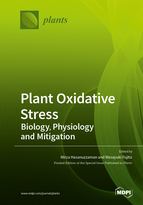Plant Oxidative Stress: Biology, Physiology and Mitigation
A special issue of Plants (ISSN 2223-7747). This special issue belongs to the section "Plant Response to Abiotic Stress and Climate Change".
Deadline for manuscript submissions: closed (30 November 2021) | Viewed by 46162
Special Issue Editors
Interests: antioxidants; abiotic stress tolerance; plant metabolites; ROS signaling
Special Issues, Collections and Topics in MDPI journals
Interests: plant stress physiology; plant biochemistry; abiotic stress
Special Issues, Collections and Topics in MDPI journals
Special Issue Information
Dear colleagues,
Due to climate change, plants are frequently exposed to abiotic and biotic stresses, and these stresses pose serious threats to plants. A key sign of such stresses at the molecular level is the accelerated production of reactive oxygen species (ROS), which cause oxidative stress. These ROS can induce cellular injuries by protein oxidation, lipid peroxidation, and DNA damage, which finally may result in plant cellular death. Recently, ROS have emerged as major regulatory molecules in plants, and their role in early signaling events initiated by normal cellular metabolic function and environmental stress are now well established. Under normal circumstances, there is a balance between the generation and the elimination of ROS. However, this balance can be hampered by different biotic and abiotic stresses, resulting in the generation of a large number of ROS that should be counteracted by the antioxidant machinery in cells. Finding ways to enhance the antioxidant defense system in plants is a very important task for plant biologists. Recent progress in plant molecular biology and biotechnology has been targeting the development of approaches to enhancing the antioxidant defense system in plants. New knowledge acquired through research on oxidative stress and abiotic and biotic stress tolerance in plants will help us to apply stress-responsive determinants and engineer plants with enhanced tolerance to stress.
This Special Issue welcomes original research articles, reviews, and mini-reviews on topics related to the following broad themes:
- chemistry and biology of ROS;
- generation and compartmentation of ROS;
- oxidative stress due to various abiotic stresses (salt, drought, extreme temperatures, toxic metals/metalloids, flooding, etc.);
- oxidative stress to due various biotic stress (pathogens, insects, weeds, etc.);
- ROS signaling;
- the dual role of ROS;
- ROS as protective agents;
- oxidative stress markers;
- use of molecular biology to understand oxidative stress; and
- antioxidant defense system in plants.
Prof. Dr. Mirza Hasanuzzaman
Prof. Dr. Masayuki Fujita
Guest Editors
Manuscript Submission Information
Manuscripts should be submitted online at www.mdpi.com by registering and logging in to this website. Once you are registered, click here to go to the submission form. Manuscripts can be submitted until the deadline. All submissions that pass pre-check are peer-reviewed. Accepted papers will be published continuously in the journal (as soon as accepted) and will be listed together on the special issue website. Research articles, review articles as well as short communications are invited. For planned papers, a title and short abstract (about 100 words) can be sent to the Editorial Office for announcement on this website.
Submitted manuscripts should not have been published previously, nor be under consideration for publication elsewhere (except conference proceedings papers). All manuscripts are thoroughly refereed through a single-blind peer-review process. A guide for authors and other relevant information for submission of manuscripts is available on the Instructions for Authors page. Plants is an international peer-reviewed open access semimonthly journal published by MDPI.
Please visit the Instructions for Authors page before submitting a manuscript. The Article Processing Charge (APC) for publication in this open access journal is 2700 CHF (Swiss Francs). Submitted papers should be well formatted and use good English. Authors may use MDPI's English editing service prior to publication or during author revisions.
Keywords
- abiotic stress
- reactive oxygen species
- stress signaling
- lipid peroxidation
- antioxidant defense
- hydrogen peroxide
- ascorbate–glutathione pathway








